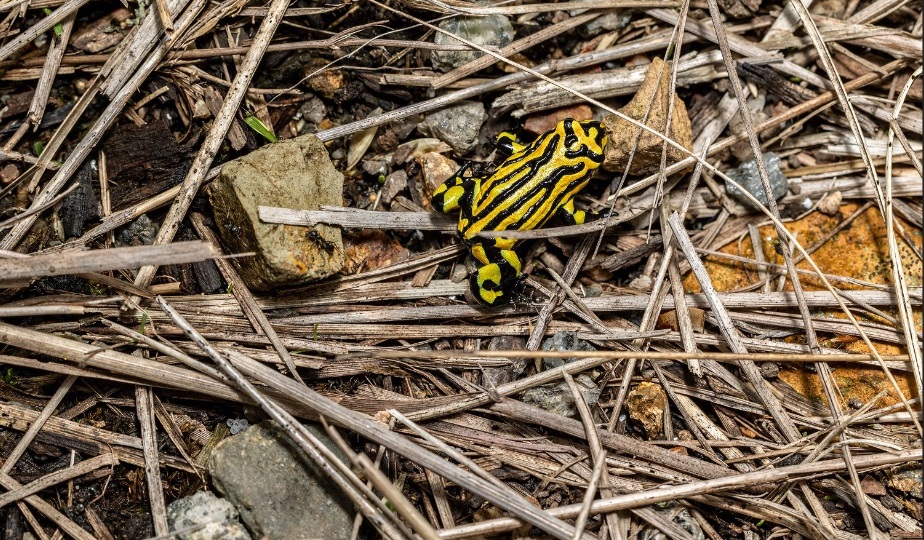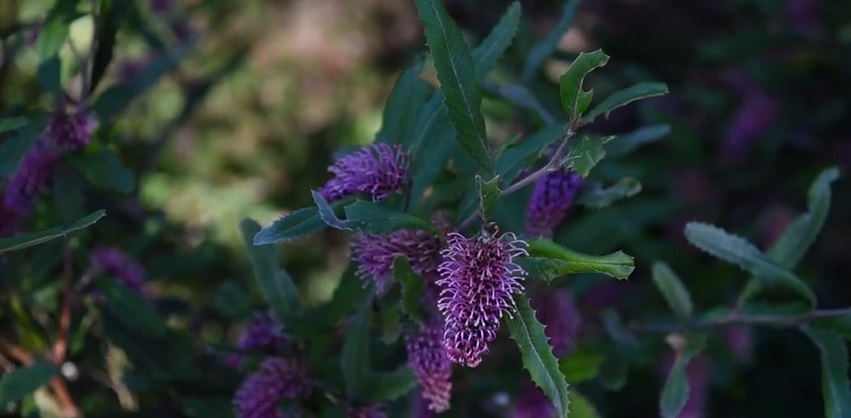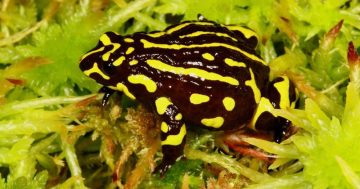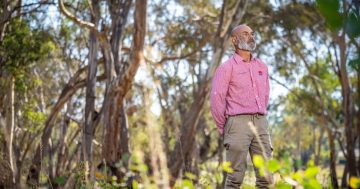
A newly released Southern Corroboree Frog. Photo: Alex Pike, DPE.
A project to connect Aboriginal communities with Country is also helping conserve three critically endangered species: the Tumut Grevillea shrub and the Southern and Northern Corroboree Frogs.
The Buugang Wambal project in Tumut and the Snowy Mountains is one of nine projects in NSW contributing to the understanding of how ecosystems can be improved when Aboriginal people are involved in looking after traditional lands.
In Wiradjuri language, Buugang Wambal refers to the Bogong Moth Mountain, one site on which the project has focused conservation efforts.
The local Aboriginal community had identified the Southern and Northern Corroboree Frogs as culturally significant but many had never been able to see the critically endangered amphibians in their natural habitat of the sphagnum bogs and wetlands in Kosciuszko National Park.
Southern Corroboree Frogs have been under threat since the late 1990s; listed as critically endangered due to a fatal disease caused by chytrid fungus, they have also been impacted by pests, bushfires and climate change.
Overseen by the NSW Department of Planning and Environment’s Cultural Fire Management Unit and the Saving Our Species program, the Buugang Wambal project is helping conservation efforts by maintaining and improving large enclosures for the frogs in the Khancoban area of Kosciuszko National Park as part of continued efforts to boost numbers.
After previous enclosures were threatened by the 2019-20 bushfires, in March 2022 and February 2023, juvenile frogs bred in captivity at Taronga Zoo were released into the park, using new field enclosures fitted with irrigation systems for fireproofing.
Remote cameras allow for monitoring and surveying.
One part of the project involves investigating whether cultural burning around the frog enclosures could protect frogs from larger bushfires.

Seeds from the rare purple-flowered Tumut Grevillea are being collected for research and regeneration. Photo: Stuart Cohen, NSW DPE.
But it’s also the Tumut Grevillea benefiting from the Buugang Wambal project as seeds are collected around Tumut to determine how they, and the plants, react to low-heat traditional burning led by traditional owners.
The species is relatively iconic given it was only discovered on a roadside near the Snowy Valleys town in 1982, is endemic to a small riverside section and produces purple flowers, rare among the 360 variants of the Australian native plant.
Two coordinators are leading a project group of up to 25 Walgalu and Wiradjuri adults and 10 children, with support from organisations including Aboriginal Affairs NSW, the Department of Regional NSW and the Rural Fire Service.
One of those coordinators is Megan Considine, a Wiradjuri-Walgalu woman.
“Our people used to call out to the Corroboree Frog, or ‘gyak’, when they came to the High Country and if the frog called back they could continue on through Country to their ceremony grounds, so being able to save the frogs and improve the habitat is very important to us,” she said.
“The group is also imparting culture through visits to the caves in Kosciuszko National Park around Mount Jagungal and Bogong Peaks Wilderness Area, where Aboriginal ancestors collected migrating Bogong Moths.”
The moths were considered by Aboriginal populations from multiple clans and language groups to provide an ample food source due to their large numbers and high fat content.
An array of methods was used to create meals from the moths, from cooking them in a fire or grinding them into cakes or a paste that could then be smoked and preserved for weeks.
NSW Minister for Lands and Property Steve Kamper said the Buugang Wambal project was connecting and teaching young people about traditional Aboriginal culture while supporting the protection of endangered animal and plant species.
“The program has brought young people to see Northern Corroboree Frogs in their High Country landscape and hear the Corroboree Frog story from their elders, and with this traditional knowledge they have been keen to continue their age-old cultural custodianship of the frog and its habitat,” he said.
NSW Environment Minister Penny Sharpe said the Corroboree Frog was close to extinction.
“This iconic and culturally significant NSW species would be lost forever without intervention,” she said.
“Working closely with First Nations people is key to recovering threatened species such as the Corroboree Frog.”
The collaboration between Saving our Species, the NPWS, Taronga Zoo, Zoos Victoria, and the Walgalu and Wiradjuri traditional owners made their survival possible, the Minister added.
“Working closely with First Nations people is key to recovering threatened species such as the Corroboree Frog,” she said.
Original article published by Edwina Mason on About Regional.









